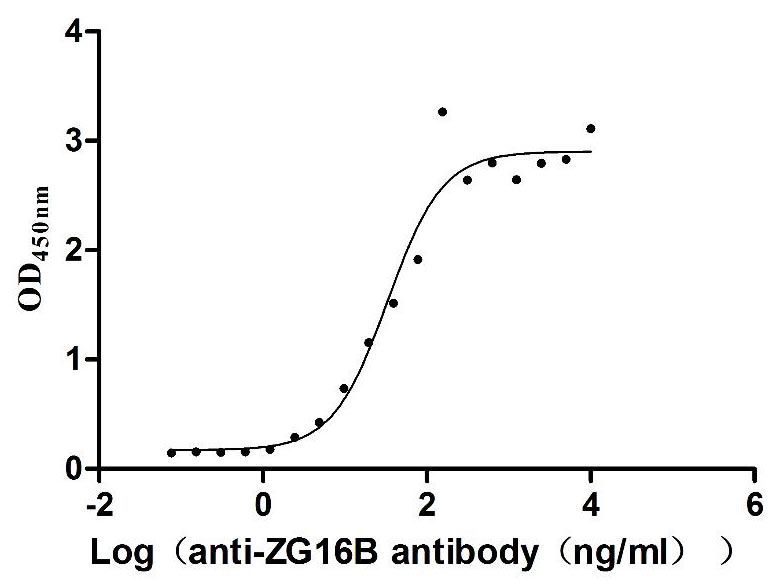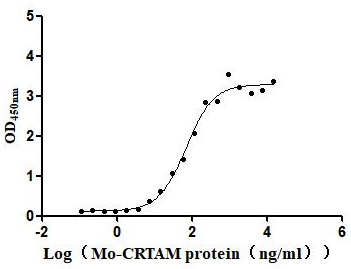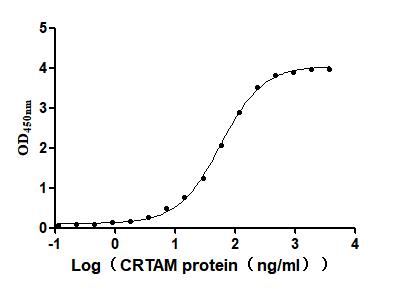Recombinant Human Keratin, type II cytoskeletal 6A (KRT6A)
-
中文名稱:人KRT6A重組蛋白
-
貨號:CSB-EP012561HUe0
-
規(guī)格:¥1344
-
圖片:
-
其他:
產(chǎn)品詳情
-
純度:Greater than 90% as determined by SDS-PAGE.
-
基因名:KRT6A
-
Uniprot No.:
-
別名:CK-6A; CK-6D; CK6A; CK6C; CK6D; Cytokeratin-6A; Cytokeratin-6D; K2C6A_HUMAN; K6A; K6C ; K6D; keratin 6A; Keratin; Keratin; type II cytoskeletal 6A; Keratin-6A; Krt6a; KRT6C; KRT6D; type II cytoskeletal 6A; Type-II keratin Kb6
-
種屬:Homo sapiens (Human)
-
蛋白長度:Full Length of Mature Protein
-
來源:E.coli
-
分子量:86.9kDa
-
表達(dá)區(qū)域:2-564aa
-
氨基酸序列ASTSTTIRSHSSSRRGFSANSARLPGVSRSGFSSVSVSRSRGSGGLGGACGGAGFGSRSLYGLGGSKRISIGGGSCAISGGYGSRAGGSYGFGGAGSGFGFGGGAGIGFGLGGGAGLAGGFGGPGFPVCPPGGIQEVTVNQSLLTPLNLQIDPTIQRVRAEEREQIKTLNNKFASFIDKVRFLEQQNKVLETKWTLLQEQGTKTVRQNLEPLFEQYINNLRRQLDSIVGERGRLDSELRGMQDLVEDFKNKYEDEINKRTAAENEFVTLKKDVDAAYMNKVELQAKADTLTDEINFLRALYDAELSQMQTHISDTSVVLSMDNNRNLDLDSIIAEVKAQYEEIAQRSRAEAESWYQTKYEELQVTAGRHGDDLRNTKQEIAEINRMIQRLRSEIDHVKKQCANLQAAIADAEQRGEMALKDAKNKLEGLEDALQKAKQDLARLLKEYQELMNVKLALDVEIATYRKLLEGEECRLNGEGVGQVNISVVQSTVSSGYGGASGVGSGLGLGGGSSYSYGSGLGVGGGFSSSSGRAIGGGLSSVGGGSSTIKYTTTSSSSRKSYKH
Note: The complete sequence including tag sequence, target protein sequence and linker sequence could be provided upon request. -
蛋白標(biāo)簽:N-terminal GST-tagged
-
產(chǎn)品提供形式:Liquid or Lyophilized powder
Note: We will preferentially ship the format that we have in stock, however, if you have any special requirement for the format, please remark your requirement when placing the order, we will prepare according to your demand. -
緩沖液:Tris-based buffer,50% glycerol
-
儲存條件:Store at -20°C/-80°C upon receipt, aliquoting is necessary for mutiple use. Avoid repeated freeze-thaw cycles.
-
保質(zhì)期:The shelf life is related to many factors, storage state, buffer ingredients, storage temperature and the stability of the protein itself.
Generally, the shelf life of liquid form is 6 months at -20°C/-80°C. The shelf life of lyophilized form is 12 months at -20°C/-80°C. -
貨期:Basically, we can dispatch the products out in 1-3 working days after receiving your orders. Delivery time may differ from different purchasing way or location, please kindly consult your local distributors for specific delivery time.Note: All of our proteins are default shipped with normal blue ice packs, if you request to ship with dry ice, please communicate with us in advance and extra fees will be charged.
-
注意事項:Repeated freezing and thawing is not recommended. Store working aliquots at 4°C for up to one week.
-
Datasheet & COA:Please contact us to get it.
相關(guān)產(chǎn)品
靶點(diǎn)詳情
-
功能:Epidermis-specific type I keratin involved in wound healing. Involved in the activation of follicular keratinocytes after wounding, while it does not play a major role in keratinocyte proliferation or migration. Participates in the regulation of epithelial migration by inhibiting the activity of SRC during wound repair.
-
基因功能參考文獻(xiàn):
- Manipulating K6a phosphorylation or ubiquitin-proteasome system (UPS) activity may provide opportunities to harness the innate immunity of epithelia against infection. PMID: 29191848
- Several missense polymorphisms in KRT6A, KRT6B and KRT6C that lead to a higher risk for dental caries. PMID: 29357356
- KRT6A genetic mutation is associate with the development of Pachyonychia Congenita in patients in Australia. PMID: 27041546
- we here describe a family with pachyonychia congenita K6a, manifesting atypical symptoms of impaired wound healing and cheilitis. PMID: 24708461
- Keratin-derived antimicrobial peptides (KDAMPs) and their synthetic analogs exhibit antimicrobial activity against bacterial pathogens. PMID: 23006328
- Genotype-phenotype correlations among PC patients with codon-125 mutation in KRT16 were established, while the phenotypes caused by the IVS8-2A>C mutation in KRT6A need further studies to confirm the rare feature of fissured tongue PMID: 22668561
- We observed a higher likelihood of oral leukokeratosis in individuals harboring KRT6A mutations. PMID: 22264670
- Phenotypic differences exist between KRT6A and KRT16 mutations support adoption of a new classification system. PMID: 22098151
- This report is the first case of pachyonychia congenita with laryngeal obstruction in which the gene mutation has been established (a deletional mutation in keratin 6a). PMID: 21554383
- Focal palmoplantar keratoderma is associated with mutations in keratin K6c in 3 families. 2 unrelated families have Asn172 del and the other has a deletion of AA 462-470. Review. PMID: 20470930
- these data highlight the possibility of a physiological role for K6/K16 heterodimers in keratinocyte cell migration, in addition to the heterodimer's known functions in cell differentiation and mechanical resilience. PMID: 20403371
- The mutation of 521T--> C in the K6A gene is the causing mutation in pachyonychia congenita type I. PMID: 20140871
- Mutations Y465H and N171D of the KRT16A gene were detected in the sporadic pachyonychia congenita cases. PMID: 19806570
- Four new missense and five known mutations in K6a, one new deletion and three previously identified missense mutations in K16, plus one known mutation in K17 are reported in pachyonychia congenita. PMID: 17719747
- PC-1 is due to mutations of the KRT16 gene or its expression partner KRT6A, wheres PC-2 is caused by mutations in the KRT17 or KRT6B genes. PMID: 18489596
- Three novel and four recurrent keratin 6A (KRT6A) mutations were found in Chinese patients with pachyonychia congenita type 1 PMID: 19416275
- Rapamycin selectively inhibits expression of an inducible keratin (K6a) in human keratinocytes and improves symptoms in pachyonychia congenita patients. PMID: 19699613
顯示更多
收起更多
-
相關(guān)疾?。?/div>Pachyonychia congenita 3 (PC3)蛋白家族:Intermediate filament family組織特異性:Expressed in the corneal epithelium (at protein level).數(shù)據(jù)庫鏈接:
Most popular with customers
-
Recombinant Human Glypican-3 (GPC3) (G537R), partial (Active)
Express system: Mammalian cell
Species: Homo sapiens (Human)
-
Recombinant Rat Microtubule-associated protein tau (Mapt) (Active)
Express system: Mammalian cell
Species: Rattus norvegicus (Rat)
-
Recombinant Human Zymogen granule protein 16 homolog B (ZG16B) (Active)
Express system: Mammalian cell
Species: Homo sapiens (Human)
-
Recombinant Macaca fascicularis lymphocyte antigen 6 family member G6D (LY6G6D) (Active)
Express system: Yeast
Species: Macaca fascicularis (Crab-eating macaque) (Cynomolgus monkey)
-
Recombinant Mouse Cell adhesion molecule 1 (Cadm1), partial (Active)
Express system: Mammalian cell
Species: Mus musculus (Mouse)
-
Recombinant Human Oncostatin-M (OSM), partial (Active)
Express system: Mammalian cell
Species: Homo sapiens (Human)
-
Recombinant Human CD81 antigen (CD81), partial (Active)
Express system: Mammalian cell
Species: Homo sapiens (Human)
-
Recombinant Mouse Cytotoxic and regulatory T-cell molecule (Crtam), partial (Active)
Express system: Mammalian cell
Species: Mus musculus (Mouse)



-AC1.jpg)

















